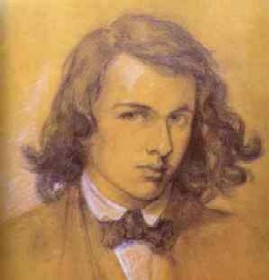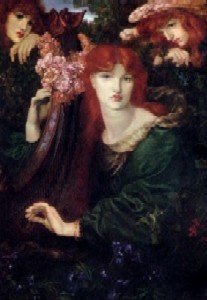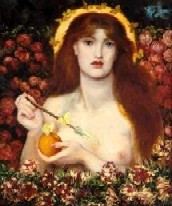» Dante Gabriel Rossetti Biographyby Susan Belmont - August 5, 2003 |
 One of the young master painters who started the Pre-Raphaelite movement in
mid-1800s, Rossetti had a very personal style, easily recognizable, and his paintings always showed the characters as having strong and deep personalities and as mystical individuals.
One of the young master painters who started the Pre-Raphaelite movement in
mid-1800s, Rossetti had a very personal style, easily recognizable, and his paintings always showed the characters as having strong and deep personalities and as mystical individuals.
The Candle Lights Up
Dante Gabriel Rossetti was born in London in 1828, son of a Dante Alighieri scholar and Italian political exile and of the daughter of Dr. John Polidori (Lord Byron's doctor, and one of the first to write vampire stories).
Rossetti's sisters and brother also became poets and scholars, due to the cultural education they received at home from their parents and grandfather.
Since an early age, Rossetti and his siblings used to write and he soon developed a passion for drawing and painting. After studying in art academies for 7 years, from 1841 to 1848, he decided he could go on without anymore guiding and
quit school.
In the year of 1848, the Pre-Raphaelite movement was founded by painters Holman
Hunt and John Everett Millais, who were inspired by the painters of the period
before the Renaissance (i.e. before the painter Raphael), thus the origin of
the name.
By this time Rossetti was working on his first important painting and finishing a series of writings and some translations of Dante's works. Still in that same year, the painter made friends with William Holman Hunt, who was exhibiting his paintings at the Royal Academy. They went to live together in Hunt's apartment and under his supervision, Rossetti progressed his technique.
Soon Rossetti joined Hunt and his friends in the "Pre-Raphaelite Brotherhood", and together they all started revolutionizing the arts of their times, with their mythological and eerie images. 
In The Brotherhood
Apart from Rossetti there were other strong creative forces in the group, like James Collinson, and there was also Holman Hunt's attitude against academic art, and all this brought even more notoriety to them, because at that time positioning oneself against the active rules was something very polemical.
Later on Rossetti met two Oxford students: painter Edward
Burne-Jones and poet William Morris who became two of the main artists of the
group.
Two of the main influences of this Brotherhood were first of all, Malory's "Morte D'Arthur", the first novel of tales of King Arthur and his knights to become known in Europe and the other was the book of the critic and Oxford's art teacher John Ruskin called "Modern Painters", that opened new horizons to the young artists. Their first exposed paintings were signed merely with the acronym PRB and were very well received.
In 1849, Hunt and Rossetti went on a trip to Belgium and Paris where they studied the works of old medieval and renaissance masters. When they returned, the Brotherhood started to plan a journal to popularize their ideas. That was when the periodical "The Germ" was created, whose first issue would be released in early 1850, and would have only three more issues.
This year wasn't a successful one to the group, as they faced much criticism when they exposed their works, but fortunately they had someone important enough to defend their ideals, it was John Ruskin.
He went in public to declare them "serious artists", which returned their credibility and solidified the group's position in the English artistic environment. Rossetti and Ruskin became close friends afterwards, but when people started to refer to them too frequently as master and pupil, he moved away.
Another important fact of that same year was that Rossetti met Elizabeth Siddal, who was the daughter of a cutler, and who became his main muse. Although through the years he was inspired by the beauty of other women such as Fanny Cornforth and Jane Morris, his wonder for Elizabeth never weakened.
But their relationship was never an easy one and it had a tragic end when Elizabeth killed herself with an overdose of laudanum in 1862, only 2 years after their marriage.
Through the 1850s, Rossetti worked on his paintings and abandoned writing for some time, but he wasn't content with the results of his works and that was when he started to paint in water color.
 In 1857,
Rossetti and the other Pre-Raphaelite painters were hired to work on a mural for the Debating Hall of Union Society in Oxford, but as they didn't know how to prepare the walls before painting on them, the ink vanished.
In 1857,
Rossetti and the other Pre-Raphaelite painters were hired to work on a mural for the Debating Hall of Union Society in Oxford, but as they didn't know how to prepare the walls before painting on them, the ink vanished.
The Flame Goes Higher
In spite of this dismal detail, the event attracted more attention to Rossetti and the other members. In that same year,
he was hired with other painters to illustrate a collection of poems of Lord Tennyson (the creator of the "Lady of Shalott" poem), and his work on that book was the culminating point of his career.
In 1861, Rossetti put together the collection of translations of Italian poets that was called "Dante and his circle", which was one of the most important works of his literary career. When Elizabeth died in 1862, he was about to publish a second collection of
his own poems, but decided to bury the texts with her. Only 7 years later he would recover the texts from her grave.
Through the 1860s, Rossetti worked more on paintings than on poetry, and the Dantescan and Arthurian images of the beginning of his career, gave place to erotic female paintings, probably inspired by his involvement with Fanny Cornforth, who became his muse of the period.
Also great changes happened in his life: Rossetti moved to Cheyne Walk, a street in the bohemian district of Chelsea in London, retreated himself from social life, narrowed his social circle, got addicted to Chloral and stopped exhibiting.
 This isolation would only grow through time as he became more and more famous and his works more and more expensive, but out of this withdrawal would come some of
Rossetti's best works, both in poetry and in painting.
This isolation would only grow through time as he became more and more famous and his works more and more expensive, but out of this withdrawal would come some of
Rossetti's best works, both in poetry and in painting.
Between 1866 and 67 he wrote poems to a few of his paintings, like "Venus Verticordia" (that can be seen at left). That was when he thought about his previous poetic works and with the help of some friends he unburied them from his beloved's grave.
Rossetti revised these works, added new poems and published them only in 1870 in a book simply called "Poems".
A critic called Robert Buchanan started a huge controversy on this book, when he wrote that it was indecent, and throughout the country many critics and Rossetti's fans fought in the newspapers defending or helping accuse his works.
Even Rossetti himself joined the fight when he wrote an essay to a newspaper about foolish censorship. Only after the painter's death, Buchanan would recognize the value of Rossetti's poetical work (which was something totally useless at that time, in my point of view).
The Candle Slowly Blows Off
In 1870, Rossetti moved again, this time to a country house in Hastings, as an attempt to run away from his agitated social life. That was when he wrote another series of poems partially inspired by his undying love for Elizabeth and by his new love for Jane Morris, poet William Morris' wife. Their relationship progressed during the next 3 years, but inevitably she had to leave with her family in 1874 and their romance ended.
During that time, he wrote much poetry, and although after Jane's departure he seemed to have giving up to total dissipation, he continued to paint and write his poetry. In 1881, he published all those works in the book "Ballads and Sonnets" and also a new edition of his old success "Poems".
In his last year of life, Rossetti sank even more in his addiction to Chloral, and in spite of two attempts to restore his health, he died in 1882 in Burchington, UK.
Download Dante Gabriel Rossetti's poems now! (Zip file size: 8 KB)
If you want more information:
About Rossetti
About the Pre-Raphaelite movement
*This work's rights belong to the author. No reproduction allowed without the author's consent. If you want to link to this article from your site, please read our privacy policy about it. Thank you!*
::: home ::: visual arts section :::
Copyright © 2003 Susan Belmont